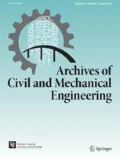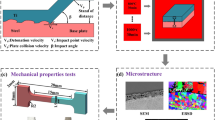Abstract
Platinum/titanium (Pt/Ti) bimetal composite is of utmost interest to the electrochemical industry for its superior functionality. Here, an improved explosive welding (EW) technology was introduced to join Pt foil and Ti sheet, and the microstructure evolution of the achieved Pt/Ti joint as well as the thermodynamic behaviors during the EW process was systematically investigated by various microscopic observations and smoothed particles hydrodynamics (SPH) simulation. It was found that the Pt/Ti EW interface was featured by a straight metallurgical reaction layer with a width of ~ 30 μm, and its formation mechanism was related to localized melting followed by intense mechanical mixing of participant metals. In the reaction layer, both elements of Pt and Ti were detected, and the average phase was determined to be Pt0.69Fe0.31. The EBSD analyses revealed a remarkable grain structure change near the interface, such as grain orientation deflection in Pt matrix, heat-induced grain growth in Ti matrix, and the formation of extra fine nanograins in the reaction layer. The SPH simulation well captured the morphology features of the Pt/Ti interface, and quantificationally revealed the extreme thermodynamic states of high heat of ~ 2000 K, high pressure of ~ 5 GPa, and large strain of ~ 3 during the EW process. Finally, the nanoindentation results revealed inhomogenous mechanical behaviors near the bonding interface.








Similar content being viewed by others
Data availability
The raw/processed data required to reproduce these findings cannot be shared at this time due to technical or time limitations.
References
Hiwarkar AD, Singh S, Srivastava VC, Thakur C, Mall ID, Lo SL. Electro-chemical mineralization of recalcitrant indole by platinum-coated titanium electrode: multi-response optimization, mechanistic and sludge disposal study. Int J Environ Sci Te. 2018;15:349–60.
Pushpavanam RM. Electroless deposition of platinum on titanium substrates. Mater Chem Phys. 2001;68:62–5.
Basirun WJ, Pletcher D, Saraby-Reintjes A. Studies of platinum electroplating baths part iv. deposits on copper from Q Bath. J Appl Electrochem. 1996;26:873–80.
Igumenov IK, Gelfond NV, Galkin PS, Morozova NB, Buleev M. I, Corrosion testing of platinum metals CVD coated titanium anodes in seawater-simulated solutions. Desalination. 2001;136:273–80.
Schemed U, Seidel H. Effect of high temperature annealing on the electrical performance of titanium /platinum thin films. Thin Solid Films. 2008;516:898–906.
Fujishiro S, Eylon D. Improvement of Ti alloy fatigue properties by Pt ion plating. Metall Trans A. 1980;11:1259–63.
Noolu NJ, Kerr HW, Zhou Y, Xie J. Laser weldability of pt and ti alloys. Mater Sci Eng A. 2005;397:8–15.
Blazynski TZ. Explosive welding. Elsevier, New York: Forming and Compaction; 1983.
Bataev IA, Tanaka S, Zhou Q, Lazurenko DV, Junior AJ, Bataev AA, et al. Towards better understanding of explosive welding by combination of numerical simulation and experimental study. Mater Des. 2019;169:107649.
Chu Q, Zhang M, Li J, Yan C. Experimental and numerical investigation of microstructure and mechanical behavior of titanium/steel interfaces prepared by explosive welding. Mater Sci Eng A. 2017;689:323–31.
Yang M, Xu JF, Ma HH, Lei MZ, Ni XJ, Shen ZW, et al. Microstructure development during explosive welding of metal foil: morphologies, mechanical behaviors and mechanisms. Compos Part B-Eng. 2021;212:108685.
Xu J, Yang M, Chen D, Ma H, Shen Z, Zhang B, Tian J. Providing a new perspective for obtaining high-quality metal coatings: fabrication and properties studies of TA2 foil on Q235 steel by explosive welding. Arch Civ Mech Eng. 2021;21(3):1–11.
Yang M, Xu J, Chen D, Ma H, Shen Z, Zhang B, Tian J. Understanding interface evolution during explosive welding of silver foil and Q235 substrate through experimental observation coupled with simulation. Appl Surf Sci. 2021;566:150703.
Yang M, Ma HH, Shen ZW, Huang ZC, Tian QC, Tian J. Dissimilar material welding of tantalum foil and Q235 steel plate using improved explosive welding technique. Mater Des. 2019;186:108348.
Yang M, Ma HH, Shen ZW. Study on self-restrained explosive welding with high energy efficiency. Int J Adv Manuf Tech. 2018;99:3123–32.
Zhang Z, Feng D, Liu MB. Investigation of explosive welding through whole process modeling using a density adaptive SPH method. J Manuf Process. 2018;35:169–89.
Corbett BM. Numerical simulations of target hole diameters for hypervelocity impacts into elevated and room temperature bumpers. Int J Impact Eng. 2006;33:43–440.
Pradeep P, Parchuri K, Kotegawa S, Yamamoto H, Ito K, Mori A, Hokamoto K. Benefits of intermediate-layer formation at the interface of Nb/Cu and Ta/Cu explosive clads. Mater Des. 2019;166:107610.
Lei MZ, Yang M, Ni XJ, Ma HH, Xu SL. Experiment and simulation investigations on w/cu components prepared by strong confinement thermal explosive welding. Nucl Mater Energy. 2021;29:101086.
Paul H, Chulist R, Miszczyk M, Lityńska-Dobrzyńska L, Cios G, Gałka A, Szlezynger M. Towards a better understanding of the phase transformations in explosively welded copper to titanium sheets. Mater Sci Eng A. 2020;784:139285.
Chen X, Inao D, Tanaka S, Mori A, Li X, Hokamoto K. Explosive welding of Al alloys and high strength duplex stainless steel by controlling energetic conditions. J Manuf Process. 2020;58:1318–33.
Yang M, Xu JF, Ma HH, Shen ZW, Zhang BY, Cheng DG. Elucidating the formation mechanism of the vortex at the Ta/Fe explosively welded interface using microstructure characterizations and numerical simulations metall. Mater Trans A. 2022;53:364–9.
Paul H, Chulist R, Lityn´ Ska-Dobrzyn´ Ska L, Prazmowski M, Faryna M, Mania I, Szulc Z, Miszczyk MM, Kurek A. Interfacial reactions and microstructure related properties of explosively welded tantalum and steel sheets with copper interlayer. Mater Des. 2021;208:109873.
Xu JF, Yang M, Ma HH, Shen ZW, Zhang BY, Rui TA, Zhao RJ. Experimental and numerical investigations on the microstructural features and mechanical properties of explosive welded niobium-steel interface. Mater Des. 2022;218:110716.
Zhang H, Jiao KX, Zhang JL, Liu J. Microstructure and mechanical properties investigations of copper-steel composite fabricated by explosive welding. Mater Sci Eng A. 2018;731:278–87.
Sapanathan T, Raoelison RN, Buiron N, Rachik M. In situ metallic porous structure formation due to ultra high heating and cooling rates during an electromagnetic pulse welding. Scripta Mater. 2017;128:10–3.
Lee T, Nassiri A, Dittrich T, Vivek A, Daehn GS. Microstructure development in impact welding of a model system. Scr Mater. 2020;178:203–6.
Paul H, Miszczyk MM, Chulist R, Prażmowski M, Morgiel J, Gałka A, Faryna M, Brisset F. Microstructure and phase constitution in the bonding zone of explosively welded tantalum and stainless steel sheets. Mater Des. 2018;153:177–89.
Zhang T, Wang W, Zhang W, Wei Y, Cao X, Yan Z. Microstructure evolution and mechanical properties of an aa6061/az31b alloy plate fabricated by explosive welding. J Alloy Compd. 2017;735:1759–68.
Okamoto H. Pt-Ti (Platinum-Titanium). J Phase Equilib Diffus. 2009;30:217–8.
Ji C, Chen L, Long Y, Xu QJ. Dynamic behaviors of multi-layered steel targets with air gaps subjected to the impact of EFP simulants. Int J Prot Structures. 2015;6:65–80.
Segal VM. Materials processing by simple shear. Mater Sci Eng A. 1995;197:157–64.
Fronczek DM, Chulist R, Litynska-Dobrzynska L, Kac S, Schell N, Kania Z, Szulc Z, Wojewoda-Budka J. Microstructure and kinetics of intermetallic phase growth of three-layered A1050/AZ31/A1050 clads prepared by explosive welding combined with subsequent annealing. Mater Des. 2017;130:120–30.
Chu Q, Xia T, Zhao P, Zhang M, Zheng J, Yan F, Luo H. Interfacial investigation of explosion-welded Al/steel plate: the microstructure, mechanical properties and residual stresses. Mater Sci Eng A. 2022;833:142525.
Liu K, Chen P, Ran C, Zhou Q, Feng J, Fan X. Investigation on the interfacial microstructure and mechanical properties of the w-cu joints fabricated by hot explosive welding. J Mater Process Tech. 2021;300:117–400.
Mousavi SAAA, Sartangi PF. Experimental investigation of explosive welding of CP-titanium/AISI 304 stainless steel. Mater Des. 2009;30:459–68.
Zeng XY, Li XQ, Li XJ, Mo F, Yan HH. Numerical study on the effect of thermal conduction on explosive welding interface. Int J Adv Manuf Technol. 2019;104:2607–17.
Zhou Q, Feng JR, Chen PW. Numerical and experimental studies on the explosive welding of tungsten foil to copper. Materials. 2017;10:984.
Nassiri A, Vivek A, Abke T, Liu B, Lee T, Daehn G. Depiction of interfacial morphology in impact welded ti/cu bimetallic systems using smoothed particle hydrodynamics. Appl Phys Lett. 2017;110:231601.
Song J, Kostka A, Veehmayer M, Raabe D. Hierarchical microstructure of explosive joints: example of titanium to steel cladding. Mater Sci Eng, A. 2011;528:2641–7.
Yang M, Ma H, Shen Z, Cheng DG, Deng YX. Microstructure and mechanical properties of Al-Fe meshing bonding interfaces manufactured by explosive welding. T Nonferr Metal Soc. 2019;29(4):680–91.
Rosenthal I, Miriyev A, Tuval E, Stern A, Frage N. Characterization of explosionbonded Ti-alloy/steel plate with Ni interlayer [J]. Metallograp Microstruct Analy. 2014;3:97–103.
Venkateswaran P, Xu ZH, Li XD. Determination of mechanical properties of Al-Mg alloys dissimilar friction stir welded interface by indentation methods [J]. J Mater Sci. 2009;44:4140–7.
Zhang H, Jiao KX, Zhang JL, Liu J. Comparisons of the microstructures and micro-mechanical properties of copper/steel explosive-bonded wave interfaces. Mater Sci Eng A. 2019;756:430–41.
Yang M, Ma H, Yao D, Shen Z. Experimental study for manufacturing 316L/CuCrZr hollow structural component, Fusion. Eng Des. 2019;144:107–18.
Acknowledgements
The reported research is supported by the Natural Science Foundation of the Anhui Higher Education Institution (No. KJ2021A0461), Independent subject of State Key Laboratory of Mining Response and Disaster Prevention and Control in Deep Coal Mines (No. SKLMRDPC20ZZ07), Anhui Province Natural Science Foundation (No. 2108085QA40), University-level key projects of Anhui University of science and technology (No. xjzd2020-03), and the National Science Foundation for Young Scientists of China (12102427, 12102202).
Author information
Authors and Affiliations
Corresponding author
Ethics declarations
Conflict of interest
We declare that we do not have any commercial or associative interest that represents a conflict of interest in connection with the work submitted.
Ethical approval
This article does not contain any studies with human participants or animals performed by any of the authors.
Additional information
Publisher's Note
Springer Nature remains neutral with regard to jurisdictional claims in published maps and institutional affiliations.
Rights and permissions
Springer Nature or its licensor (e.g. a society or other partner) holds exclusive rights to this article under a publishing agreement with the author(s) or other rightsholder(s); author self-archiving of the accepted manuscript version of this article is solely governed by the terms of such publishing agreement and applicable law.
About this article
Cite this article
Wang, F., Yang, M. Experimental and numerical investigations of platinum foil/titanium plate interfaces prepared by explosive welding. Archiv.Civ.Mech.Eng 23, 51 (2023). https://doi.org/10.1007/s43452-022-00591-6
Received:
Revised:
Accepted:
Published:
DOI: https://doi.org/10.1007/s43452-022-00591-6




